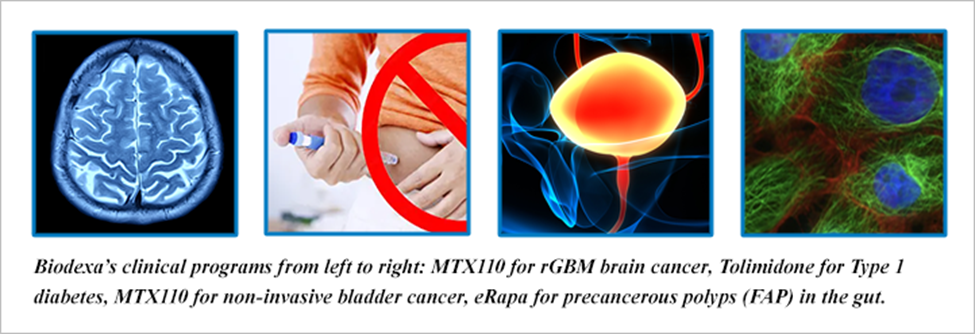Gaining Momentum, Biodexa is Advancing Two Recent Acquisitions Through the Clinic
Rhea-AI Summary
Biodexa Pharmaceuticals (NASDAQ:BDRX) is advancing its transformation from a drug delivery innovator to a therapeutics company, focusing on diabetes and cancer treatments. The company's strategy involves repurposing proven molecules for new indications. Their key product eRapa for familial adenomatous polyposis (FAP) showed promising Phase 2 results with a 29% median decrease in polyp burden and 89% non-progression rate. The Phase 3 study is largely funded through a $25.5 million grant and matching funds. Additionally, Biodexa is developing MTX110 for glioblastoma and tolimidone for Type 1 diabetes, with several clinical milestones expected in the coming months.
Positive
- Phase 2 eRapa trial showed strong results with 29% polyp reduction and 89% non-progression rate
- Secured $25.5 million in funding for eRapa Phase 3 trial through FDA submission
- eRapa market potential estimated at $500M-$1B peak annual sales
- MTX110 showed significant survival improvement in glioblastoma patients (12-13 months vs. 2-9 months)
- Strategic acquisitions completed with minimal upfront costs (5% and 9.9% stock payments)
Negative
- Company bearing all development costs for licensed products
- Revenue sharing agreements with licensors will impact future profits
- Multiple clinical trials requiring significant ongoing investment
News Market Reaction 1 Alert
On the day this news was published, BDRX gained 14.29%, reflecting a significant positive market reaction.
Data tracked by StockTitan Argus on the day of publication.
CARDIFF, UK / ACCESSWIRE / November 21, 2024 / Biodexa Pharmaceuticals PLC (NASDAQ:BDRX), an acquisition-focused clinical-stage biopharmaceutical company focused on developing treatments for unmet medical needs, has made significant progress in transforming itself from a drug delivery innovator to a therapeutics company with a focus on drugs to fight diabetes and cancer.

Biodexa's strategy is not based on discovering new medicines; rather it looks to reduce the risk of failure in the clinic by re-purposing molecules with proven safety records for new indications. When Biodexa sees potential, it acquires these products from third parties under licensing agreements which generally call for the company to bear the costs of development and share the rewards of commercialization with the licensor.
eRapa soon to enter Phase 3
The shift to a therapeutics company is paying off for Biodexa as illustrated by its recent acquisition of eRapa for familial adenomatous polyposis, or FAP. FAP is an inherited condition that puts people at a much greater risk of developing colon cancer. With FAP, hundreds or thousands of precancerous polyps grow throughout the gastrointestinal tract. There is no approved therapeutic option for treating FAP patients, for whom active surveillance and surgical resection of the colon and/or rectum remain the standard of care. People with FAP - which usually appears in adolescence - end up eventually having their entire colon removed and using a colostomy bag. If left untreated, there is a
"eRapa could be a transformational deal for Biodexa," says Biodexa CEO Stephen Stamp. "The deal included an upfront payment of only
As covered by Benzinga earlier this year, Biodexa published six-month phase 2 data, as well as 12-month data for eRapa that showed a median decrease in polyp burden of
Phase 3 Through To NDA Largely Funded
The FAP program was awarded a
"There are approximately 40,000 and 60,000 patients with FAP in the US and Europe respectively. As an orphan drug, eRapa will benefit from seven and 10 year exclusivity in the US and Europe, respectively, and based on the pricing of other orphan drugs, could achieve peak annual sales of
It doesn't end there. Biodexa said there is currently an ongoing placebo-controlled phase 2 study of eRapa for non-muscle invasive bladder cancer (NMIBC), an early-stage bladder cancer. Biodexa said about 130 of 168 patients have been recruited so far, and it is evaluating the possibility of an interim analysis around the end of the year.
Furthermore, in October, the company announced the status of patients in Cohort A of the phase 1 study of its drug MTX110 - a solubilized formulation of the cancer drug panobinostat which is marketed as Farydak® - for recurrent glioblastoma, the most common and aggressive malignant primary brain cancer: all patients at that point had overall survival of between 12 and 13 months since starting treatment with MTX110, a significant improvement on overall survival of 2 to 9 months in the background population.
Tolimidone, a Phase 2-Ready Asset For Type 1 Diabetes
The company is currently working with the University of Alberta to initiate a Phase 2a dose confirmation study of tolimidone for the treatment of Type 1 diabetes. The study is designed to build on the preclinical data, which Biodexa said suggested tolimidone could have a proliferative impact on pancreatic beta cells, the cells responsible for insulin production.
Biodexa in-licensed tolimidone from Melior Discovery in December 2023 in return for
"Over the next few months, we can expect the outcome of the Type C meeting with FDA on eRapa phase 3 program, the start of recruitment of the registrational Phase 3 study of eRapa in FAP, the start of recruitment of a Phase 2a study of tolimidone in Type 1 diabetes and interim analysis of eRapa phase 2 study in NMIBC," said Stamp. "Another busy and productive period for our team here at Biodexa."
Featured photos by:
Salah Uddin on iStockphoto
Photo sourced from Shutterstock
MagicMine on iStockphoto
National Cancer Institute on Unsplash
This post contains sponsored content. This content is for informational purposes only and is not intended to be investing advice.
Click here for more information on Biodexa Pharmaceuticals.
Contact:
Stephen Stamp, CEO, CFO
ir@biodexapharma.com
Important notice, please read: The information and statistical data contained herein may contain forward-looking statements that reflect the company's intentions, expectations, assumptions, or beliefs concerning future events, including, but not limited to, expectations with respect to FDA and other regulatory bodies approval of new products, technology, and product development milestones, the ability of the company to leverage its product development and negotiate favorable collaborative agreements, the commencement of sales, the size of market opportunities with respect to the company's product candidates and sufficiency of the company's cash flow for future liquidity and capital resource needs and other risks identified in the Risk Factor Section of the company's Annual Report and any subsequent reports filed with the SEC. We do not undertake to advise you as to any change in this information. The forward-looking statements are qualified by important factors that could cause actual results to differ materially from those in the forward-looking statements. In addition, significant fluctuations in quarterly results may occur as a result of varying milestone payments and the timing of costs and expenses related to the company's research and development programs. This is not a solicitation of any offer to buy or sell. Redington, Inc. is paid by Biodexa Pharmaceuticals PLC to provide investor relations services, and its employees or members of their families may from time to time own an equity interest in companies mentioned herein.
SOURCE: Biodexa Pharmaceuticals
View the original press release on accesswire.com








